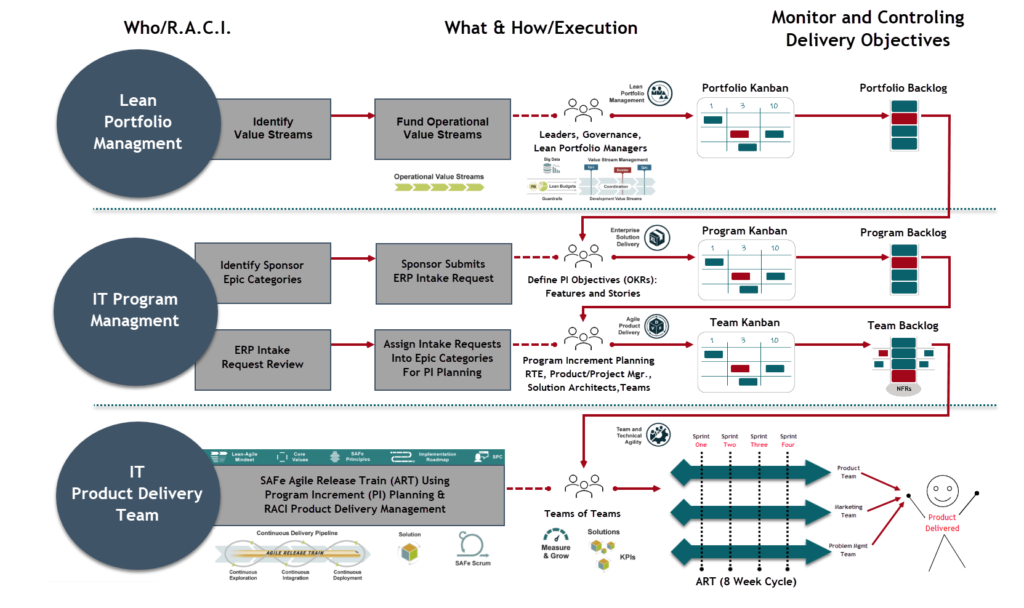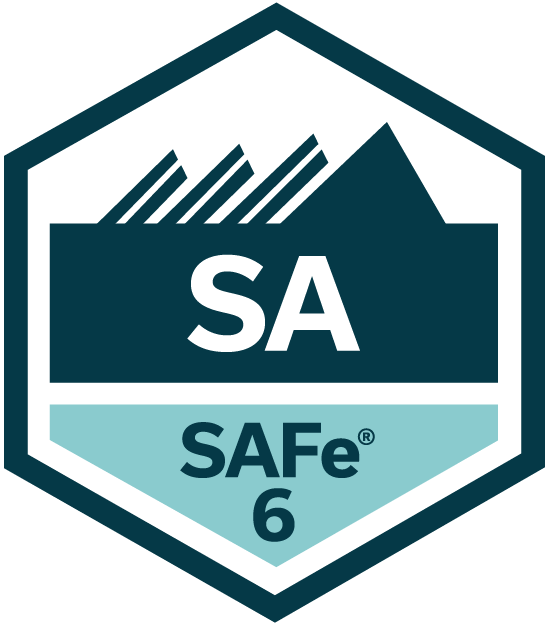The Scaled Agile Framework and Your Business Organization

Using the Scaled Agile Framework (SAFe) process offers a variety of benefits to any business organization, especially when it comes to implementing a successful strategy for portfolio, program and project management to achieve efficient product delivery goals. Therefore, I would like to share a graphic art interpretation (and explanation) for how SAFe can be beneficial in your business organization by using the right rigor, agile tools, project management techniques, define organizational roles and stakeholder responsibilities (See graphic image).
Here are some of my proven benefits to a business organization when SAFe methodology has been used with purpose and good intention:
Increased Flexibility and Adaptability: Over the last several years I have used agile methodology to reach my product delivery goals through organizational agility within any DevOps team that I have worked with in order to achieve efficient product delivery to business stakeholders despite changing requirements. If there are unanticipated customer requirements, along with fluid business deliverable objectives that are difficult to interpret under any circumstances, then I rely upon my experience using the Scaled Agile Framework (SAFe) process to help me organize my DevOps team to make the adjustments needed to discern a challenging project scope and/or prioritize product delivery needs accordingly.
Delivering Business Value Faster: When a DevOps leader is looking for a better way to handle their portfolio management strategy, I recommend trying the SAFe methodology because it can help a DevOps team deliver smaller chunks of product value (faster) in iterative sprint increments (i.e. ideally in 8 week cycles). I have had significant product delivery success with SAFe DevOps teams by creating incremental project plans (e.g. MS Project, Smartsheet, Asana, etc.) to clearly define a work breakdown structure to show how to deploy the SAFe agile methodology to implement a product or service more efficiently. For example, in my prior DevOps role(s) (e.g. IT Project Manager, Expert Business Analyst), I have had successful experiences planning, monitoring and executing product delivery to stakeholders in days or weeks rather than quarterly or after several months.
Improved Collaboration: Scaled Agile Framework methodology emphasizes good communication and collaboration among cross-functional teams, including analysts, developers, testers, and product owners. In order to successfully change a DevOps culture to be more efficient, it requires process improvements such as daily stand-ups and various types of team agility meetings in order to help ensure that everyone is on the same page and that problems are quickly identified and addressed. For example, backlog review, backlog grooming, requirements refinement, code reviews, inspect & adapt, retrospectives and product demos.
Read more benefits to deploy DevOps with SAFe…
Higher Quality: As a SAFe Agilist, I will advocate for my DevOps team in order to promote high quality planning, design quality, continuous implementation of product development procedures, deploy good testing models, product review, and business requirements refinement, which often leads to a higher-quality product. When a DevOps team does a good job of defining use cases in the analysis phase of a project, then issues can be detected and fixed early thereby reducing constraints on the overall project plan which can set-up a domino effect of concise milestones for a successful product delivery.
Better Stakeholder Engagement: Any software development life cycle (i.e. either agile or waterfall) requires good communication that encourages constant feedback from leaders, stakeholders and customers to ensure that the end product aligns with their expectations.
Risk Mitigation: Problems can be managed before they become larger and more costly when a R.A.C.I. document is used to clearly define DevOps team roles and responsibilities. “RACI” stands for responsible, accountable, consulted and informed. A risk register should be used to capture all issues, risks and decisions about risk mitigation.
Continuous Improvement: It is my goal to help any DevOps process to sustain continuous improvement after each sprint by conducting retrospectives in order to discuss what went well, what didn’t, and how processes can be improved. This promotes an ongoing cycle of learning and refinement, both in terms of agile product development, team dynamics but also helping everyone maintain a broad level of perspective to help mitigation risks (or issues) toward the “tipping point” in any volatile situation.
Enhanced Customer Satisfaction: By delivering smaller increments of business value in 8 week sprints, the SAFe agile methodology ensures a better chance for customer satisfaction because the DevOps team is set-up to successfully deliver valuable business features faster. This constant delivery of value leads to better satisfaction, as the customer sees progress and can provide input along the way.
Empowered Teams: The role of a SAFe Agilist on a DevOps team is a mentor who fosters self-organizing teams, giving them the autonomy to make decisions and help them establish processes to manage their workload more efficiently. The empowerment of autonomy in a DevOps team leads to greater motivation, innovation, and a sense of ownership for project success rather than disfunction.
Predictable Costs and Timelines: One of the most predictable features of SAFe is to help LEAN portfolio managers to organize their business model around delivering their objectives and business value by using the agile iterative process, because it makes business analysis easier to make good cost estimate forecast and manage timelines more accurately. By implementing the right SAFe process in a DevOps team during each sprint, the team can reassess and adjust as needed, thereby providing better control (efficiency) over the project budget and target delivery schedule. In short, Agile is beneficial because it helps teams to be more responsive, efficient, and aligned with customer needs which ultimately will lead to higher-quality products and better project outcomes for all stakeholders.
Mark Adams, SAFe Agilist 6.0
